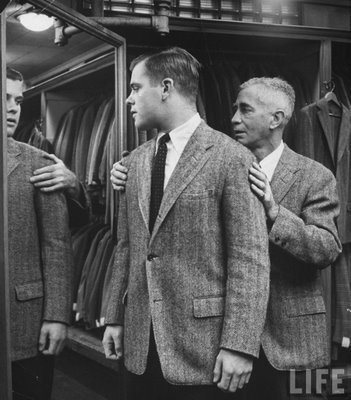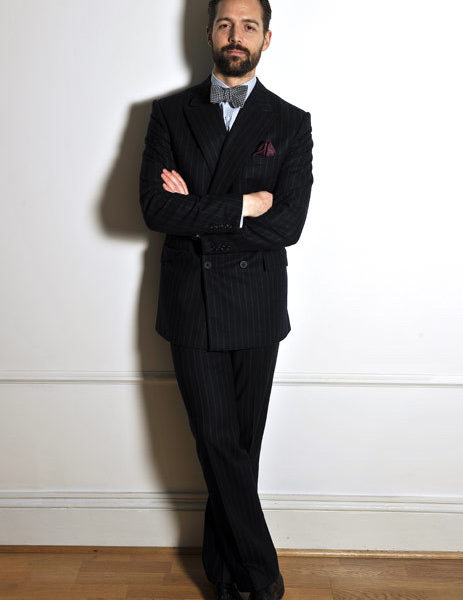
Our most recent video, Tradition, features a conversation with Jay Walter, a true-blue American style traditionalist. The American aesthetic is largely a creation of the mid-20th century, and after some years of being maligned, it’s being re-evaluated at the moment, as “Ivy League” style (a close variant) has its moment.
Above are two men in tailored clothing. In black and white, we see a customer at J. Press in the mid-20th century. In color, we see a contemporary photo of Patrick Grant, proprietor of Norton & Sons, a Savile Row tailor. Each of these guys is wearing an outfit that couldn’t be more emblematic of their nation’s signature styles.
Difference to note (pictured and unpictured):
- The American suit features what’s called a 3-roll-2 buttoning arrangement. That means that there are three buttons on the front,but only two are openly visible and only one is intended to be used. The third (top) button rolls under the lapel. This is a classic button arrangement for suits of any nation, but it’s particularly vital to the American look. The English suit is in a classic English configuration: a narrow double-breasted.
- The shoulders of the American jacket are soft and nearly unpadded. This is called a “natural shoulder,” and it’s comfortable and casual. Contrast this with the built-up, strongly-shaped shoulder on the Savile Row suit.
- The American jacket lacks darts (folds, sewn into the fabric for shape) on the front. Most continental jackets have a dart on each side, running from about nipple level to the waist. This gives the jacket shape over and above the shaping permitted by the side seams. The classic undarted American coat is called a “sack,” because, well, it’s sack-like, rather than following the countour of the front of the body.
- The classic American jacket has a single vent in the back, often a “hook vent.” The hook vent, a J. Press innovation, is cut wider at the top (giving it a hook-like shape) to prevent awkward splaying. An English coat is typically double-vented (sometimes called side-vented), which helps prevent splaying. Sometimes it’s unvented, in the style of the “golden age” of men’s style, the 1930s.
- Pants in the classic American suit are, as Jay Walter described in our piece, typically flat-front, rather than pleated. They often have plain fronts as well. Generally, this is a simpler, more relaxed style.
There are of course other difference in the aesthetics – Americans have a predilection for button-down collars, even sometimes wearing them with suits, for example. The knit tie is a particularly Ivy League aesthetic. Belts are favored over braces, and loafers, especially penny loafers, are beloved.
The end result is a distinctive, American aesthetic. The shape is youthful. Because it lacks darts, the jacket falls straight, rather than emphasizing the shoulders and chest and narrowing the waist. The goal here is to attain the slim, straight body of the 20 year old, rather than the strong-shouldered, broad-chested body of the Powerful Man favored on Savile Row.
Of course, this style is just as much associated with an insurance salesman in Muskogee as it is with a young Bobby Kennedy. On the hefty man these youngsters of the 1950s and 60s became, the look has a different effect. The shapelessness and weak shoulders of the look can make a heavy man look, for lack of a better word, dumpy. Still: it is classic, comfortable and proudly American.
What’s important to remember is that a suit’s silhouette isn’t an absolute value, following exactly the curves of the body. There are choices about what to emphasize, what to de-emphasize, what to build up and what to slim down. These are informed by individual aesthetics and cultural tradition. I hope this will help you make informed choices for your own wardrobe.
